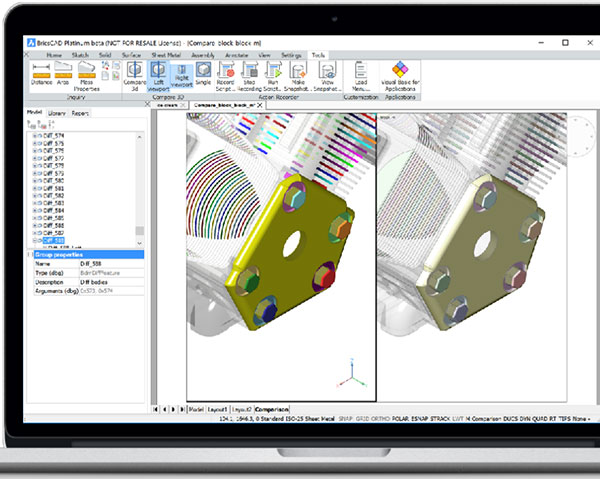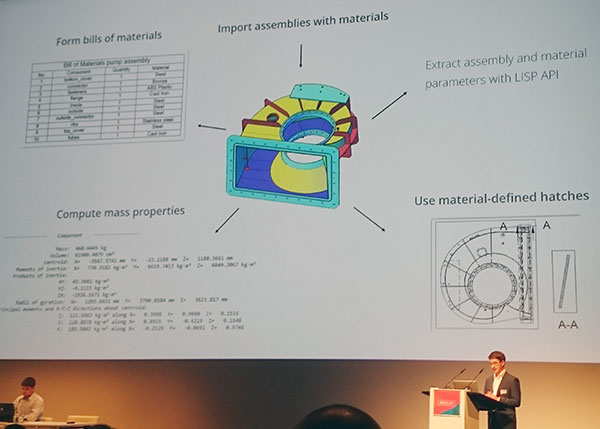
The new 3D Compare feature in BricsCAD compares 3D solids and surfaces, including imported geometry. Image courtesy of Bricsys.
October 31, 2016
 Among the many new features in BricsCAD 2017 for mechanical design demonstrated at the recent Bricsys Annual Conference in Munich is a new routine for importing assemblies with materials. Image courtesy of Randall S. Newton.
Among the many new features in BricsCAD 2017 for mechanical design demonstrated at the recent Bricsys Annual Conference in Munich is a new routine for importing assemblies with materials. Image courtesy of Randall S. Newton.Autodesk’s AutoCAD has dominated the CAD marketplace for more than 30 years. By actions and statements, Autodesk presents the 2D CAD represented by AutoCAD as the past and 3D CAD as represented by its Inventor, Fusion and Revit as the future. Yet even with the rise of 3D CAD, there are still more seats of 2D CAD in active use today. For example, Dassault Systemès has more professional users on its 2D CAD DraftSight than on its 3D products CATIA and SOLIDWORKS combined.
In a move continuing to stir debate among users, this year Autodesk completed the shift of its business model from selling software as a product with a perpetual use license to selling subscriptions for software use.
It is at this point in the twin debates of 2D vs. 3D and perpetual vs. subscription that Bricsys would like to enter the conversation. For 15 years this CAD developer based in Ghent, Belgium has offered BricsCAD, .dwg-based software that has proven popular with a small army (1,500+) of specialty engineering software vendors. At the Bricsys International Conference in Munich this month, Bricsys CEO Erik de Keyser said there is a growing market for continuing to empower the .dwg format for contemporary use, and for offering customers perpetual software licenses. In recent years Bricsys has added functionality that takes it far beyond being an AutoCAD clone for both AEC (architecture, engineering and construction) and manufacturing.
Throwing Down the Gauntlet
In an impassioned keynote to start the conference, CEO de Keyser described the current approach at Autodesk as a “user-hostile path.” The millions of users of .dwg-compatible software — who own billions of drawings — deserve a software platform that offers them a future. Bricsys said it can guarantee a .dwg approach to both 2D drawing and 3D modeling that offers:
- 100% cloud collaboration for both 2D and 3D;
- parametric objects;
- access to BricsCAD and third-party add-ons using web browser tech;
- a built-in database (SQLite); and
- artificial intelligence.
Some of these features were demonstrated in BricsCAD 2017; others (such as artificial intelligence, aka machine learning) are in the early stages of development. “We can own .dwg’s second life,” de Keyser told the audience of more than 1,000 developers. “Twelve million .dwg users have spent three decades on it and spent a fortune in training, [and now] Autodesk wants them to start over.”
“Stick with .dwg” was the conference slogan, and Bricsys has proven over the years it has the will to make itself a player to be taken seriously. Outside the US, Bricsys has a thriving market, based not only on its retail sales of BricsCAD but also its close working relationship with its network of 1,500+ third-party developers. De Keyser said in 2015 Bricsys invested 47% of revenue back into research and development, and promises the company will continue to do this. “Focus, but dare!” was his challenge to developers. To convince the market of the value of moving to Bricsys, de Keyser offered five keys:
- Continue to extend the viability of .dwg by creating better technology.
- Provide a familiar user experience requiring minimal training.
- Leverage past investments of both customers and developers.
- Offer a rich choice of applications.
- Increase revenue with better licensing and training opportunities.
BrisCAD and BrisCAD Sheet Metal Updates
For manufacturing, Bricsys offers not only the standard BricsCAD product but also a separate product: BricsCAD Sheet Metal, a 2D/3D tool that uses lofted surfaces to create sheet metal features. Bricsys said their method does a better job of helping designers create manufacturable products, and that it maintains the model’s integrity better than competing solutions when parts are unfolded, refolded and modified.
 The new 3D Compare feature in BricsCAD compares 3D solids and surfaces, including imported geometry. Image courtesy of Bricsys.
The new 3D Compare feature in BricsCAD compares 3D solids and surfaces, including imported geometry. Image courtesy of Bricsys.Dmitry Ushakov leads the development of mechanical modeling tools at Bricsys as the CEO of Bricsys Technology Russia. He said today’s market is at a crossroads where five needs are hitting mechanical designers simultaneously:
- To collaborate in multi-CAD environments;
- to use and repurpose “huge amounts” of legacy data in the .dwg format;
- to make rapid design changes;
- to switch from 2D drawing to 3D design for competitive purposes; and
- to have more integration between design and manufacturing.
Too often, Ushakov said, designers have to “think twice before creating a 3D model, because you create not geometry but a recipe.” Despite having a considerable body of older 2D design data in-house, many designers are forced to use only one 3D software product for all design work, forcing time-consuming re-work.
The Bricsys vision for sheet metal design is based on five fundamental principles:
- Design should be as easy in 3D as it is in 2D.
- CAD users should be able to create, modify and move entities in a design directly, independently of design history.
- Imported geometry should be editable as if it were created in BricsCAD.
- There should be no obstacles to collaboration with users of other MCAD, CAM and CAE systems.
- At any design state, the user should be able to add or change parametric behavior in the model using 3D constraints and formulas.
The demonstration of BricsCAD for Sheet Metal 2017 contained the following new features, some of which are in standard BricsCAD:
Twisting a 3D model — It is possible to uniformly twist several bodies at once, like strands of wire. This twisting can work with dynamic dimensioning. This method makes fast work of designing items like drill bits, fans and augers.
Applied lofting — Lofting can be applied to existing objects, and 2D lofted elements can be converted to 3D solids.
Smart selection — Select edges for extraction to make new objects or to send to CNC for production.
Import assemblies with materials — Using a new LISP API, extract both assembly and material parameters.
Apply 3D constraints to 2D elements — Standard 2D CAD elements such as lines, arcs and circles can be granted 3D constraints. An example would be a line constrained to a solid; they will remain linked, yet need not share a common plane. Bricsys said such a feature opens the door to easier design of complex mechanisms with complex geometry, such as an irregularly shaped robot. The command can be used to create and constrain wireframe geometry to create a 3D constrained model.
3D Compare — Search for geometric similarities, including imported geometry. In the example shown during the demonstration at the Bricsys Annual Conference, two versions of a complex engine model were shown side by side. The command found identical objects common to both models in less than two seconds.
Perpetual Debate
There was considerable talk at the conference during breaks that a major announcement regarding Bricsys in North America would be forthcoming, but nothing was confirmed by Bricsys. If only one well known US-based AutoCAD add-on developer or Autodesk reseller were to move to the Bricsys platform in the next few weeks, it would send a ripple effect through the CAD industry.
Bricsys is not the only vendor continuing to push the envelope with .dwg. As we reported recently, other vendors are continuing to invest in .dwg to meet market demand. If enough users decide they want to continue to buy new seats of CAD as a perpetual license, and if Bricsys gets enough people to take a look at its technology, the next few years could truly open the door with a second life for .dwg.
Subscribe to our FREE magazine, FREE email newsletters or both!
About the Author
Randall S. Newton is principal analyst at Consilia Vektor, covering engineering technology. He has been part of the computer graphics industry in a variety of roles since 1985.
Follow DE





